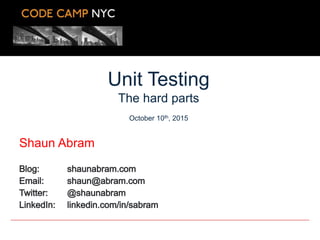
Unit testing - the hard parts
- 1. Shaun Abram Unit Testing The hard parts October 10th, 2015
- 2. Shaun Abram 2 Test Obsessed? How much do you know… Test coverage Dependency Injection Mock vs stubs Testing private or static methods Test driven development
- 3. Shaun Abram 3 What is a unit test? A piece of code that executes a specific functionality (‘unit’) in the code, and Confirms behavior or result is as expected Determines if code is ‘fit for use’ Does it do what the developer intended? Before, we manually verified, but not easily repeatable.
- 4. Shaun Abram 4 Why unit test? Economics $ but also… Drive design Create defensive code against bad input Act as safety buffers for regression bugs Provide documentation Clean code Less bugs
- 5. Shaun Abram 5 What is a unit? A class? A method? A single path through a method? The smallest testable part of an application. A single functional use case.
- 6. Shaun Abram 6 What makes a good unit test? Provides benefit! Readable, Understandable, Maintainable Independent run in any order, no DB or File access Consistent / deterministic Runs fast Tests a single logical concept in the system
- 7. Shaun Abram 7 Unit testing limitations Can not prove the absence of bugs Lot’s of code (x3-5) Some things difficult to test
- 8. Shaun Abram 8 Dependency Injection
- 9. 9
- 10. 10 Dependency Injection Useful for testing – inject test doubles Also helps reduce coupling
- 11. Shaun Abram 11 Test Doubles Mocks Stubs Dummies Spies Fakes
- 12. Shaun Abram 12 Test Doubles Mocks Stubs Dummies Spies Fakes
- 13. Shaun Abram 13 Test Doubles: Mocks Mocks: An overloaded term! uses behavior verification objects pre-programmed with expectations
- 14. 14
- 15. 15 Mocks use behavior verification Can specify how to respond when called Roll your own?
- 16. Shaun Abram 16 Test Doubles Mocks Stubs Dummies Spies Fakes
- 17. Shaun Abram 17 Test Doubles: Stubs ‘stubs out’ or provides a simplified version of the implementation for the purposes of testing
- 18. 18
- 19. 19 Stubs can use state or behavior verification Provides a useful approach for test fixture configurability
- 20. Shaun Abram 20 Test Doubles Mocks Stubs Dummies Spies Fakes
- 21. Shaun Abram 21 Test Doubles: Dummies A very dumb class! Contains next to nothing - enough to compile Pass when you don’t expect to be used
- 22. 22 Use dummies with state or behavior verification Can create as inner class Can replicate with mocks
- 23. Shaun Abram 23 Unit Testing – the tricky parts Legacy code Privates Statics
- 24. Shaun Abram 24 General approach to testing legacy code 1) Start with coarse grained tests No modifications Strict and rigid Detect regressions Short term bridges - delete
- 25. Shaun Abram 25 General approach to testing legacy code 1) Start with coarse grained tests 2) Add finer grained tests Incrementally add more unit start gently refactoring Use TDD – if possible Test from 1) should protect you
- 26. Shaun Abram 26 General approach to testing legacy code 1) Start with coarse grained tests 2) Add finer grained tests 3) Continuously refactor Use patterns such as Extract Method/Class Move Method/Field tease apart methods (>10 lines smells)
- 27. Shaun Abram 27 Unit Testing – the tricky parts Legacy code Privates Statics
- 28. Shaun Abram 28 How do you test private methods? Indirectly! Best tested via public interface But sometimes… Legacy code With limited capability to refactor, or adding a safety net before refactoring A public method calls several private methods, each with complex logic
- 29. Shaun Abram 29 Testing Private Methods 1. Refactor 2. Change the visibility Bad practice Public API? Very bad practice! Internal & stepping stone -> lesser evil Java private -> package; .Net protected or internal? Document (@VisibleForTesting)
- 30. Shaun Abram 30 Testing Private Methods 1. Refactor 2. Change the visibility 3. Use Reflection No code modification, but… 4. Other options… Testing frameworks InternalsVisibleToAttribute Private Accessors
- 31. Shaun Abram 31 Testing static methods
- 32. 32
- 33. 33
- 34. 34
- 35. Shaun Abram 35 Testing static methods DI ideal But sometimes not pragmatic
- 36. 36
- 37. 37 Refactor to wrap the static call in an instance method Which can then be mocked…
- 38. 38
- 39. 39
- 40. 40
- 41. Shaun Abram 41 Testing static methods Refactor – use DI Wrap static call in a instance method Use a mocking framework?
- 42. Shaun Abram 42 Test Driven Development
- 43. Shaun Abram 43 Test Driven Development
- 44. Shaun Abram 44 Test Driven Development
- 45. Shaun Abram 45 Test Driven Development
- 46. Shaun Abram 46 Test Driven Development
- 47. Shaun Abram 47 Test Driven Development Red - Green – Refactor: the TDD Mantra No new functionality without a failing test No refactoring without passing tests
- 48. Shaun Abram 48 Test Driven Development Example…
- 49. Shaun Abram 49 Test Driven Development Example… Create a StringCalculator class with an add method which takes a comma separate String of numbers and returns their sum. Example input Result 0 1 1 2 2 1,2 3 1,2,100 103
- 56. Refactor?
- 61. Refactor?
- 70. These tests act like the original developer looking over your shoulder and advising you, long after that developer has left… These tests act like the original developer looking over your shoulder and advising you, long after that developer has left…
- 71. Shaun Abram 71 Recommended reading Growing Object-Oriented Software, Guided by Tests Freeman & Pryce Test Driven Development Kent Beck Refactoring: Improving the Design of Existing Code Martin Fowler, Kent Beck et. al. Effective Unit Testing Lasse Koskela
- 72. Shaun Abram 72 Recommended reading Unit Test Best Practices - https://wiki.tlcinternal.com/display/TD/Unit+Test+Best+Practices Mocks Arent Stubs - http://www.martinfowler.com/articles/mocksArentStubs.html